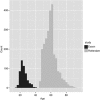Genetic determination of human facial morphology: links between cleft-lips and normal variation
- PMID: 21694738
- PMCID: PMC3198142
- DOI: 10.1038/ejhg.2011.110
Genetic determination of human facial morphology: links between cleft-lips and normal variation
Abstract
Recent genome-wide association studies have identified single nucleotide polymorphisms (SNPs) associated with non-syndromic cleft lip with or without cleft palate (NSCL/P), and other previous studies showed distinctly differing facial distance measurements when comparing unaffected relatives of NSCL/P patients with normal controls. Here, we test the hypothesis that genetic loci involved in NSCL/P also influence normal variation in facial morphology. We tested 11 SNPs from 10 genomic regions previously showing replicated evidence of association with NSCL/P for association with normal variation of nose width and bizygomatic distance in two cohorts from Germany (N=529) and the Netherlands (N=2497). The two most significant associations found were between nose width and SNP rs1258763 near the GREM1 gene in the German cohort (P=6 × 10(-4)), and between bizygomatic distance and SNP rs987525 at 8q24.21 near the CCDC26 gene (P=0.017) in the Dutch sample. A genetic prediction model explained 2% of phenotype variation in nose width in the German and 0.5% of bizygomatic distance variation in the Dutch cohort. Although preliminary, our data provide a first link between genetic loci involved in a pathological facial trait such as NSCL/P and variation of normal facial morphology. Moreover, we present a first approach for understanding the genetic basis of human facial appearance, a highly intriguing trait with implications on clinical practice, clinical genetics, forensic intelligence, social interactions and personal identity.
Figures
References
-
- Boehringer S, Vollmar T, Tasse C, et al. Syndrome identification based on 2D analysis software. Eur J Hum Genet. 2006;14:1082–1089. - PubMed
-
- Kayser M, Schneider PM. DNA-based prediction of human externally visible characteristics in forensics: motivations, scientific challenges, and ethical considerations. Forensic Sci Int Genet. 2009;3:154–161. - PubMed
-
- Kohn LAP. The role of genetics in craniofacial morphology and growth. Ann Rev Anthropol. 1991;20:261–278.
-
- Winter RM. What's in a face. Nat Genet. 1996;12:124–129. - PubMed
-
- Mossey PA, Little J, Munger RG, Dixon MJ, Shaw WC. Cleft lip and palate. Lancet. 2009;374:1773–1785. - PubMed
Publication types
MeSH terms
LinkOut - more resources
Full Text Sources
Medical



